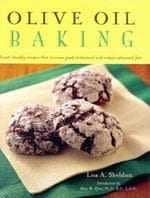
Dessert, that traditionally sinful course, has been subjected to all kinds of health considerations in recent years, from vegan needs to low cholesterol options, trans fat replacements and calorie-trimming diets. For these cases, olive oil provides a functional substitute for butter in recipes, offering its own distinct advantages of taste and texture. Good recipes produce desserts with an extraordinary richness. They differ greatly in character from the traditional butter feeling so that people concerned about health need not sacrifice the pleasure of a sumptuous dessert.
Two new books address these needs directly, and deliciously. “Olive Oil Baking: Healthy Recipes That Increase Good Cholesterol and Reduce Saturated Fats” by Lisa Sheldon, and “Olive Oil Desserts: Delicious and Healthy Heart Smart Baking”, by Micki Sannar, are chock full of traditional Mediterranean recipes and new takes on recipes customarily made with butter or vegetable oil. They also include tips on measurements and ingredient combinations for using olive oil as a replacement in any of your personal favorite recipes.
While some recipes merely use olive oil instead of butter in the pursuit of healthy baking, the best ones take into account the characteristic flavors of olive oil and oftentimes make it the star ingredient. In this vein, there are many new recipes cropping up with no apparent designs on health-consciousness, such as those in the cookbook “The Passionate Olive”, by Carol Firenze, which was written, as the title indicates, to honor a fervent love of the flavor, and not for health. For best results with these goodies, it is essential that you choose a very high quality oil with nutty or fruity notes, forgoing the more peppery varieties, and preferably choose one from a late season harvest so that the olive flavor will not overwhelm the other elements.
EVOO creates a compelling flavor when paired with dark chocolate, or an intriguingly well-balanced flavor with rosemary or citrus. The fruitier varieties are excellent in a cake with poached pears or blood orange caramel, and add a modern touch to traditional strawberry shortcake or rhubarb desserts. It makes an easy marriage with other savory elements in the dessert, as with rosemary, and gives even cheesecake a surprising new sophistication..
The following recipe has been adapted from Dorie Greenspan’s “Around My French Table”, an excellent cookbook with easy-to-replicate versions of French recipes, many of them taken from the Mediterranean south of France. This simple olive oil cake is wholesome enough to be eaten at breakfast, but you’ll be happy to have its rich flavor for an after-dinner treat as well. The rosemary is my addition, but feel free to experiment with your own variation.
Olive Oil and Yogurt Loaf Cake
Makes 8 servings
1 1/2 cups all-purpose flour
2 teaspoons baking powder
Pinch of salt
1 cup sugar
Finely grated zest of 1 lime
1/2 cup plain whole milk yogurt
3 large eggs
1/4 teaspoon pure vanilla extract
2 tablespoons chopped fresh rosemary
1/2 cup extra-virgin olive oil
Getting ready: Center a rack in the oven and preheat the oven to 350 degrees F. Generously butter an 8 1/2‑x-4 1/2‑inch loaf pan, place the pan on a lined baking sheet and set aside. Whisk together the flour, baking powder and salt and keep near by.
Put the sugar and zest in a medium bowl and rub the ingredients together until the sugar is fragrant. Whisk in the yogurt, eggs and vanilla. When the mixture is well blended, gently whisk in the dry ingredients and then the rosemary. Switch to a spatula and fold in the oil. The batter will be thick and shiny. Scrape it into the pan and smooth the top.
Bake the cake for 50 to 55 minutes, or until it is golden and starts to come away from the sides of the pan; a knife inserted into the center of the cake will come out clean. Cool on a rack for 5 minutes, then run a knife between the cake and the sides of the pan. Unmold and cool to room temperature right-side up.
Storing: You can keep the cake at room temperature for at least 4 days or freeze it for up to 2 months


 Olive Oil and Yogurt Loaf Cake
Olive Oil and Yogurt Loaf Cake






